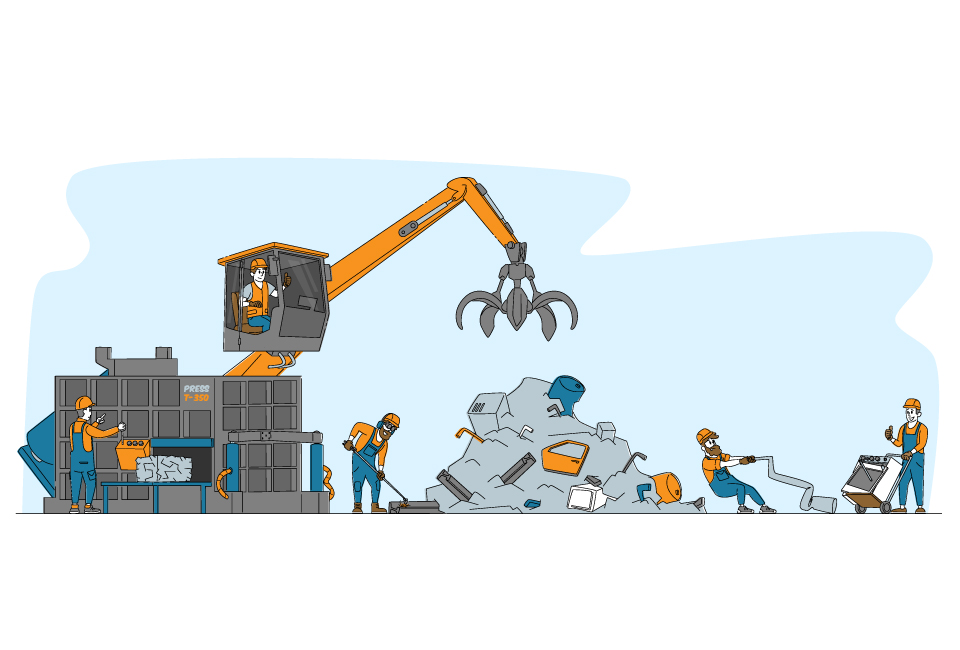

Almost 2 million tonnes of scrap metal are produced in Switzerland every year. But much of it is not sorted sufficiently and is therefore recycled at a low level. Instead of being used in vehicle construction or the machinery industry, it often ends up as a building material. This is about to change.
Thanks to intelligent technologies and new ways of thinking, «downcycling» is to be avoided in the future, and scrap metal is to be turned back into high-quality metal. Two new studies from the Lucerne University of Applied Sciences (HSLU) show how this is to be done.
Scrap can only be used to a limited extent due to contamination
Up to 95% of scrap metal in Switzerland ends up in recycling plants. Sounds good, but it is not necessarily. «The return rate alone does not say anything about the quality of recycling», explains Prof. Dr. Simon Züst, head of the research group on the subject at HSLU. Although the scrap is further processed, it can no longer be used for high-quality applications because of contamination – such as copper from cables or tin from can coatings.
For example, copper in scrap steel can no longer be removed during melting. Even the smallest amounts impair material properties such as formability and weldability. The recycled steel thus produced is no longer suitable for safety-relevant components in vehicle construction or for precise machine components. Instead, it ends up in civil engineering, for example, as steel reinforcement (reinforcement) in concrete, where lower claims to quality and purity apply.
This so-called downcycling is not only economically unattractive, but also strategically problematic: Switzerland has no economically exploitable ore deposits. «Each tonne that is recycled of high quality strengthens our independence from imports», Züst emphasizes, a factor that is particularly relevant in times of unstable trade and economic policy.
Sensors reveal scrap metal even before processing
In the project ReRe Recycling Economy for Metals, the research group investigated, among other things, the role that intelligent sensors, combined with self-learning AI, can play in detecting the material composition of scrap metal already at the point of delivery to collection points. They can identify critical components such as batteries or pressure vessels and thus enable precise and safe sorting. This not only increases the efficiency of recycling, but also the ecological and economic benefits. According to Züst, if only 15% of recycled scrap metal were recycled to a higher standard in the future, up to 36'000 tonnes of CO2 could be saved annually and an added value of around 30 million francs could be generated per year. According to the International Copper Association (2022), the effect is also significant for other metals such as aluminum, zinc and copper: cleanly recycled copper, for example, retains around 95% of its material value, as it can be reused with virtually no loss. Currently, only about half of Europe’s copper demand is recovered from recycling. So there is still room for improvement.
Systemic Approaches: Thinking Circuits Better
In the second project, REINVENT, funded by Innosuisse, the entire metal recycling system was examined: from material flows to stakeholders to business models. The aim of the study was to create a basis for a networked, sustainable circular economy for metals in Switzerland.
In addition to technological innovation, binding quality standards, reliable traceability data, and economic incentives are needed for companies that process metals, generate scrap, or engage in groupage logistics and processing. For example, recyclers’ understanding of the added value of clean recycling is crucial. Only when this is recognized will they be more willing and motivated to invest in appropriate measures, such as improved sorting processes. Bonus models for particularly sustainable practices are also conceivable. Züst is confident: «The industry is open and ready to innovate.»
Key fields of action defined
The two studies by the Lucerne University of Applied Sciences provide a concrete basis for making the metal cycle in Switzerland sustainable, resilient and import-independent. To ensure that high-quality recycling becomes the rule, the researchers recommend, among other things, the comprehensive integration of sensor technologies, the establishment of standardized data systems for traceability, and the strengthening of cooperation along the value chain. Reuse strategies should also be considered technologically, economically and regulatoryly throughout the entire system and promoted in a targeted manner. For Züst, it is clear: «High-quality recycling is not a compromise, but a key to the sustainable supply of raw materials of tomorrow.»